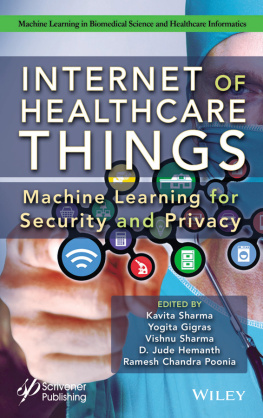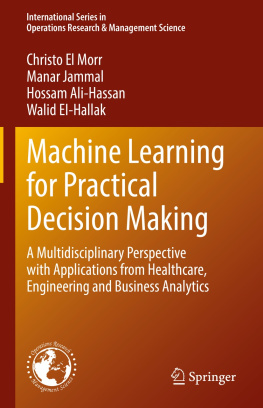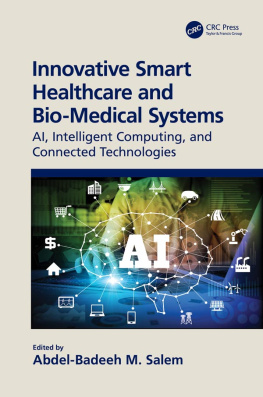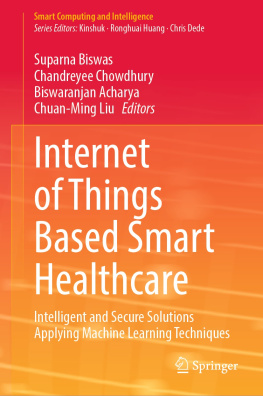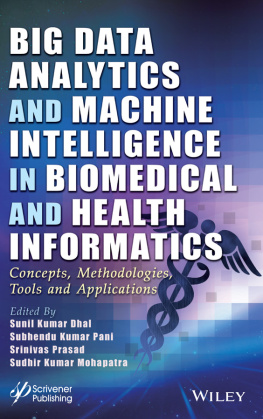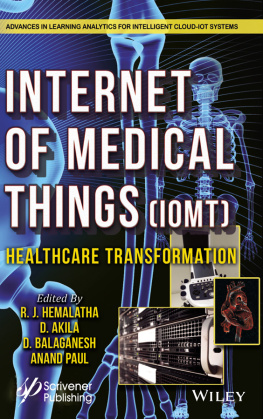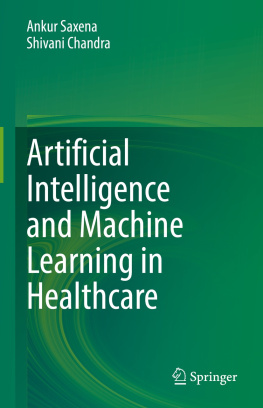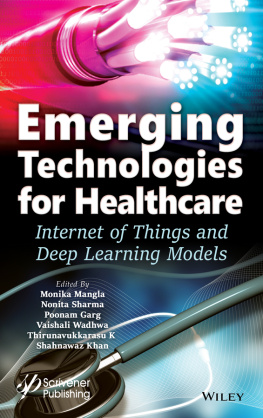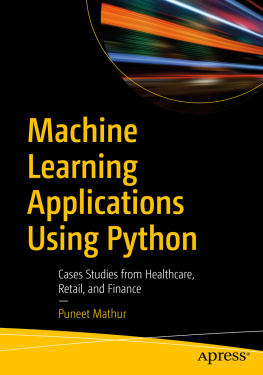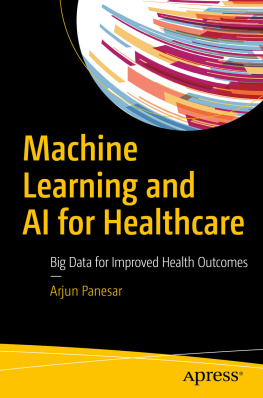
Scrivener Publishing
100 Cummings Center, Suite 541J
Beverly, MA 01915-6106
Publishers at Scrivener
Martin Scrivener ()
Phillip Carmical ()
Internet of Healthcare Things
Machine Learning for Security and Privacy
Edited by
Kavita Sharma,
Yogita Gigras,
Vishnu Sharma,
D. Jude Hemanth
and
Ramesh Chandra Poonia

This edition first published 2022 by John Wiley & Sons, Inc., 111 River Street, Hoboken, NJ 07030, USA and Scrivener Publishing LLC, 100 Cummings Center, Suite 541J, Beverly, MA 01915, USA
2022 Scrivener Publishing LLC
For more information about Scrivener publications please visit www.scrivenerpublishing.com.
All rights reserved. No part of this publication may be reproduced, stored in a retrieval system, or transmitted, in any form or by any means, electronic, mechanical, photocopying, recording, or otherwise, except as permitted by law. Advice on how to obtain permission to reuse material from this title is available at http://www.wiley.com/go/permissions.
Wiley Global Headquarters
111 River Street, Hoboken, NJ 07030, USA
For details of our global editorial offices, customer services, and more information about Wiley products visit us at www.wiley.com.
Limit of Liability/Disclaimer of Warranty
While the publisher and authors have used their best efforts in preparing this work, they make no representations or warranties with respect to the accuracy or completeness of the contents of this work and specifically disclaim all warranties, including without limitation any implied warranties of merchant-ability or fitness for a particular purpose. No warranty may be created or extended by sales representatives, written sales materials, or promotional statements for this work. The fact that an organization, website, or product is referred to in this work as a citation and/or potential source of further information does not mean that the publisher and authors endorse the information or services the organization, website, or product may provide or recommendations it may make. This work is sold with the understanding that the publisher is not engaged in rendering professional services. The advice and strategies contained herein may not be suitable for your situation. You should consult with a specialist where appropriate. Neither the publisher nor authors shall be liable for any loss of profit or any other commercial damages, including but not limited to special, incidental, consequential, or other damages. Further, readers should be aware that websites listed in this work may have changed or disappeared between when this work was written and when it is read.
Library of Congress Cataloging-in-Publication Data
ISBN 978-1-119-79176-8
Cover image: Pixabay.Com
Cover design by Russell Richardson
Set in size of 11pt and Minion Pro by Manila Typesetting Company, Makati, Philippines
Printed in the USA
10 9 8 7 6 5 4 3 2 1
Preface
In recent years, the use of the Internet of Things (IoT) has been on the rise worldwide, bringing with it new challenges and possibilities along with new cybersecurity risks in the area of IoT-enabled healthcare. These new challenges involve smart connectivity, high security, and confidentiality, generating big data, reducing total data latency between machine-to-machine interfaces, and reducing bandwidth, complexity, and power consumption. In the healthcare sector, the IoT has made it possible for devices to monitor patients health remotely, unleashing the capability to ensure their health and allowing physicians to deliver unmatched care. These IoT devices are more efficient for identifying disease in less time with more precision and have an absence of network segmentation, inadequate access control of legacy systems, and an increased susceptible surface area that cyber attackers exploit. Therefore, even though the IoT has significantly impacted healthcare costs and improving treatment results, IoT-enabled healthcare devices greatest common threats are data safety and confidentiality. Since these devices communicate and obtain data in real-time, cybercriminals can break into the system and steal the Personal Health Information (PHI) of both patients and their doctors. Even so, the IoT is certainly improving the healthcare sector by redefining the scope of the devices.
Another significant threat is the combination of numerous network devices, which creates difficulties in implementing the IoT in the healthcare sector. The enormous amount of data produced by these devices can also impede the ability of doctors to identify diseases. So, this book addresses these issues and provides solutions through authentication and authorization mechanisms, blockchain, fog computing, machine learning algorithm, etc. Machine learning-enabled IoT devices deliver the information concealed in data for fast, computerized responses and enhanced decision-making. This information might be used to plan for upcoming patterns, distinguish anomalies, and expand intelligence by audio, image and video analyses. The IoT permits devices to send information to isolate blockchain networks to generate tamper-resistant accounts of collective transactions. Blockchain empowers business associates to access and share IoT data but without the necessity of central management and control.
As the world is entering the fourth industrial revolution-otherwise known as Industry 4.0-the combination of the IoT with other technologies, such as cybersecurity, big data, cloud computing and blockchain, is fundamentally changing the healthcare industry. The development of these fields is critical in healthcare because it improves the quality and efficiency of treatments and improves the patients health.
Objective of the Book
This books main objective is to motivate the reader to use telemedicine facilities to monitor patients in remote areas and gather clinical data for further research. To this end, it provides an overview of the Internet of Healthcare Things (IoHT) and discusses the significant threats: the data security and data privacy of health records. Another major threat is the combination of numerous devices and protocols, precision time, data overloading, etc. In the IoHT, multiple devices are connected and communicate through specific protocols. Therefore, the application of emerging technologies to mitigate these threats and provide secure data communication over the network is discussed. This book also discusses the integration of machine learning with the IoHT for analyzing vast amounts of data for predicting diseases more accurately. Case studies are also given to verify the concepts presented in the book.
Organization of the Book
The 12 chapters of the book are organized into three sections. The first section consists of three chapters on data security and privacy concerns in the IoHT. The second section contains five chapters describing the application of machine learning, blockchain, and fog computing in the IoHT. The third section discusses the latest case studies in the healthcare sector.
Section 1: Security and Privacy Concerns in the IoHT (Chapters 13)
- discusses the changes and standards required for the healthcare sector, covering privacy and security concerns, requirements, existing solutions, future challenges, and privacy-preserving methods. This chapter focus to enhance the knowledge of monitoring for adverse medical events and leading to a rise in the quality of treatment for diseases.
Next page
